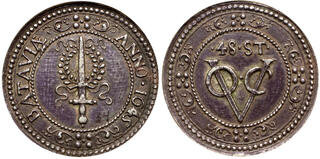| Ira & Larry Goldberg Coins & Collectibles > Auction 137 | Auction date: 29 January 2024 |
| Lot number: 1202 Price realized: 200,000 USD (Approx. 185,240 EUR) Note: Prices do not include buyer's fees. | Show similar lots on CoinArchives Find similar lots in upcoming auctions on |
| Lot description: Netherlands East Indies (modern Indonesia), silver Crown, or Kroon (also called the Daalder worth 48 Stuivers), 1645. Scholten 12; Bucknill 39; Maillet, pl. xiii, 1; Catalogus Bataviaasch Genootschap 34 (this coin); Dav-415; KM-34, and p.895, this coin. 26.02 grams. struck in Batavia (capital of the Dutch East Indies) for the Netherlands East India Company. Obverse displays an upright sword, the blade over a wreath. Outside of a circle of dots, the legend in Latin reads BATAVIAE ANNO 1645. The reverse side is dominated by the company's monogram, VOC, and above it is the "face" value of 48 Stuivers, all encircled by a ring of dots, outside of which are four arabesques. Look closely and you will see the Museum of Batavia's institution number "34" lightly inked in the obverse field to right of the sword handle. Deeply toned. Of the Highest Rarity! The finest of six known specimens. The only one put into a PCGS holder. PCGS graded About Uncirculated Detail (Tooled);. Estimated Value $50,000 - UP Dutch traders arrived in what was known as the East Indies in 1596. Their presence was powerful and they succeeded in pushing out all the Portuguese traders and settlers, within a few years gaining control of the numerous islands that are today's Indonesia under the flag of the East India Company. To combat the shortage of useful money in the now-Dutch territory, by 1601 they were issuing silver coins in sizes much like United States' dimes, quarters and half-dollars, and to a lesser extent larger coins roughly of the size of the silver dollar. As trade coins, these were respectively known as ¼ Real, ½ Real, Real, 2-Reals, and 8-Reals. The Dutch called them Daalders and their fractions (in Stuivers). They were all cast locally. They were impressive-the first round coins seen in the Orient. The largest first coins (8-Reals) quickly gained popularity among Muslim merchants because of their solid intrinsic value. Least made near the end of the VOC's control of the area was the gigantic 48-Stuivers in 1645, replacing the earlier 8-Reals. All were withdrawn circa 1647 because, being cast, they were easily counterfeited-explaining the great rarity of this largest coin. Most were undoubtedly melted, their silver made into other coins. During its impressively influential history of nearly 200 years, the Dutch East India Company (or Verenigde Oostindische Compagnie-VOC) grew to become the largest organization of its kind, and one of the most profitable, by trading in spices like nutmeg, cloves, cinnamon, pepper, and other then-scarce and coveted consumer products such as tea, silk, Chinese porcelain and especially coffee. The VOC came to dominate the Eastern spice trade. They accomplished all this while in competition with, among others, the English East India Company (EIC). Seen here is their rarest issue-the ultimate memento of their enterprise and the first silver dollar-sized coin minted for trade in the Orient! Excerpt from Jacques Schulman letter: Amsterdam, August 29th. 1986 "Speaking of rarety: Only 6 pieces of this coin are known: 1. In the Royal Coin Cabinet The Hague, in this collection already before 1890. 2. A museum in Rotterdam from our auction 1951 originally from the Rijnbende collection (1890). 3. Baldwin London bought a specimen in our november 1960 sale which originated from the Moquette collection, our sale May 1929. I have no record as to where this piece is at the moment. 4. The specimen from the Stephanik collection (sold in 1904). All coins of the Dutch East Indies were sold as one lot, the buyer however is unknown to us. 5. The Ran Zander specimen, the origin of which is not known to me. 6. This specimen. From the Museum of Batavia (hence the no. 34 in ink on the coin), and already listed in their catalogue of 1896! Further "proof" of its rarety is the fact that such famous collectors as Virgill Brand and Garett never possesed this coin." Ex Batavia Museum Collection (note ink #34 on obverse); Illustrated in Money of The World, coin 110; Ex The Millennia Collection, May, 2008 lot 909, previously in a NGC EF-45 holder, price realize $115,000. |  |


